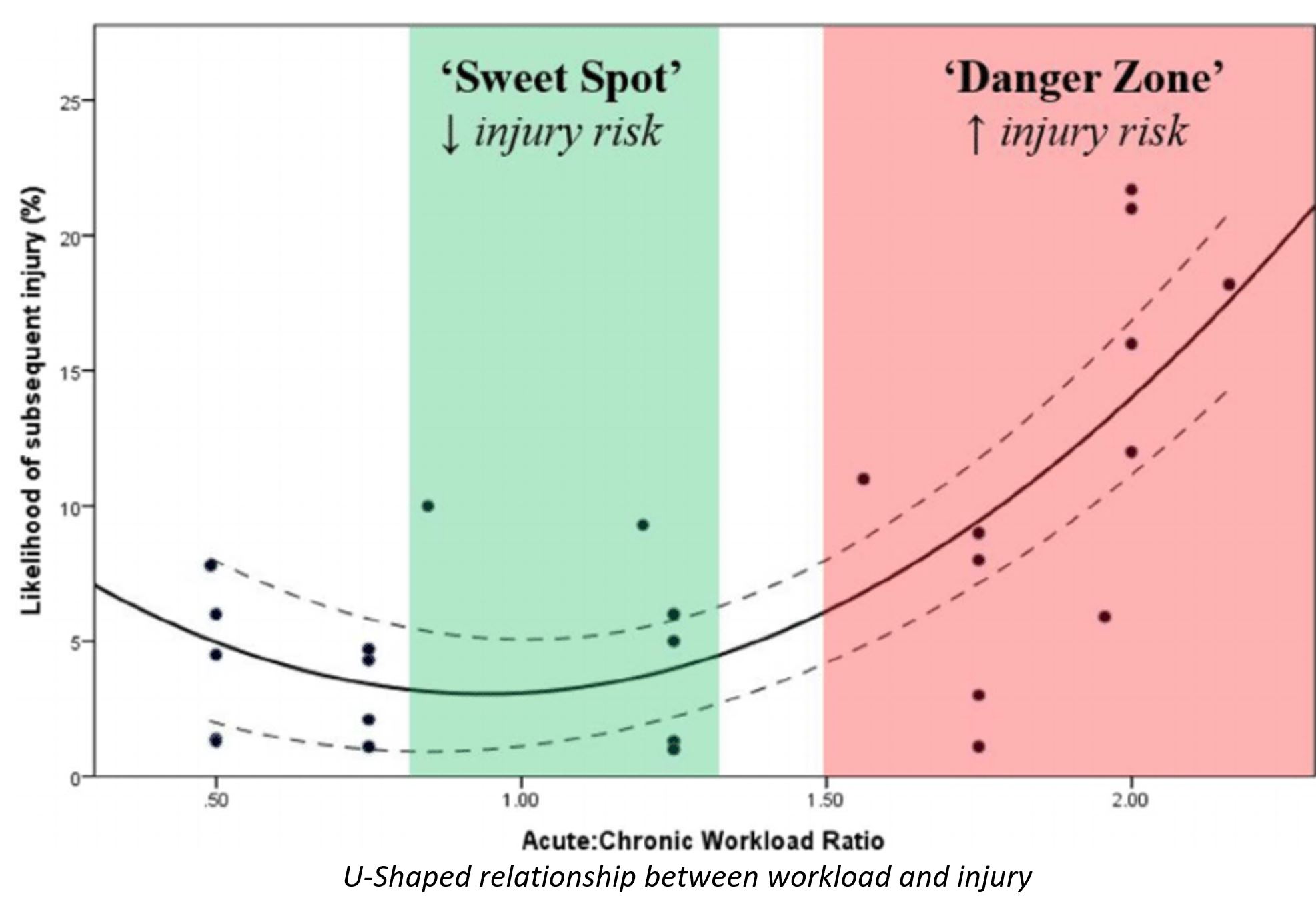Optimizing Load Management
Guest Author: Michael Kenny
Training and competition (total workload) load stimulates a series of homeostatic responses accompanying adaptation of the human body systems. The paramount principle in training theory is to use this process of biological adaptation to increase fitness and subsequently improve performance
– International Olympic Committee consensus statement on load in sport and risk of injury

From the elite of the elite professional level to amateur rankings, sport is competitive in nature. As a result, the ability to gain any competitive edge over another team or individual is desirable. One of the greatest challenges faced by coaches is load management. Using the above well understood training principle of progressive overload, most coaches are aware that to improve any fitness characteristic, providing a greater stimulus over time is necessary. However, knowing what stimulus to increase (e.g frequency, intensity, duration), as well as by how much can provide a real challenge. Several studies suggest that performance generally increases with training load, however; as research progresses further it is also well understood that poor load management (under and over-training) is a major risk factor for injury. Given that higher injury rates have been shown to negatively impact team success, the importance of appropriate loading through athlete monitoring is now generally accepted.
Training provides an increase in fitness and an increase in fatigue in a dose response manner. The fitness response can be boosted by successive training bouts. However, as time progresses in order to provide the same increase in fitness, the stimulus must regularly be increased. Similarly, fatigue accumulation will continue where the stimulus is high and/or insufficient recovery time is available. This impulse-response model was first proposed by Banister et al. in 1975 and suggests a prediction of performance can be made by the difference between the positive function of fitness (chronic workload) and the negative function of fatigue (acute workload). The difference between fitness and fatigue would provide either a positive (chronic>acute) or negative (chronic<acute) stress-training balance.
Acute Chronic Workload Ratio
The acute:chronic workload ratio is one method that is used by many Sport Science and Strength and Conditioning practitioners. The ratio provides a periodic overview of what the athletes workload has been, and therefore how prepared they are to perform. The protocol therefore allows the manipulation of training load through a greater understanding of an athletes ‘readiness to perform’ and likelihood of injury.
Speaking to Metrifit in 2016 lead researcher of the acute:chronic workload ratio Tim Gabbett stated
It’s not the load that’s the problem, it’s what you’ve prepared for
It is well documented that high workloads are not an issue, and in a study conducted by Hulin and Gabbett it is concluded that high chronic workloads are protective against injury when acute workloads are similar to chronic workload. Gabbett concludes:-
The trick is trying to build these chronic loads to try and protect you from injury and to get there in a safe way
The specific acute and chronic periods used to assess workload should be sport specific and dependent on competition congestion. For example, the periods used to assess workload in the NBA (where on average 3.5 games are played weekly for a total of 82 games) and that of the traditional Gaelic Athletic Association championship season (where it took football champions Dublin a total of 7 championship games to reach the final) may vastly differ. For the purpose of simplicity and as it is the most commonly adopted period, we will look at the acute period over 7 days, and the chronic period over the course of 28 days.
Workload can be monitored by external (e.g distance covered, number of sprints/jumps/throws, weight lifted) and internal measures (e.g session-rating of perceived exertion x session duration, heart rate). As individuality exists amongst athletes (i.e the internal response to an external stimulus) using both is likely advantageous.
Acute Workload
The acute period is represented as the fatigue element of the ratio. Ensuring the acute workload stays within a range of the chronic period is advised in the monitoring of workload and to reduce an athlete’s injury risk. This becomes even more problematic following training breaks such as at the beginning of pre-season, post injury and following low contact time such as training restrictions (such as those currently faced due to the current coronavirus pandemic) or opposingly where contact hours may increase during a team trip away.
Chronic Workload
The chronic workload is represented as the fitness element of the ratio. It is most often viewed over a 28-day period and is the average workload of the 4 weeks. This provides an indication of what the athlete has done over the previous month, and therefore how ready he/she is to perform at optimal levels.
Example
Week 1= 18,000km
Week 2= 20,000km
Week 3= 16,000km
Week 4= 20,000km
Chronic Workload= (18,000+20,000+16,000+20,000)/4= 18,500

The acute:chronic workload ratio is calculated by dividing the acute workload by the chronic workload. If we take the acute workload of week 4 (20,000km) and divide it by the chronic workload (18,500), we get a ratio of 1.08.
The interpretation and application of data
Readiness to Perform
The acute:chronic workload ratio has been shown to be useful to determine readiness to train/perform. If an athlete’s acute workload load is high and the ratio exceeds 1.0, the athlete is in a negative training-stress balance and a fatigued state. Opposingly, where the athlete’s chronic workload exceeds the acute workload ratio the athlete is in a positive training-stress balance and a well-prepared state. The ratio here will be 1 or less.
Risk of Injury
As is well documented, injury risk increases as the acute workload outweighs the chronic workload. Furthermore, the greater the increase in acute workload the larger the risk of injury. Hulin and Gabbett found a threefold and fourfold increase in injury risk when training stress balance exceeded 200% in cricket and up to a tenfold increase in the injury risk in elite rugby league players. As a result, the monitoring of training load is becoming increasingly popular in high performance sport to ensure athletes receive an adequate stimulus whilst minimizing the negative effects of training.
Taken from three different sports (rugby league, Australian football, and cricket), a guide to interpreting and applying to acute:chronic workload ratio has been provided by Blanch and Gabbett.

• <.8 = Increased risk of injury (Under-training)
• .8-1.3 = Lowest relative risk of injury (‘’The Sweet Spot’’)
• >1.5 = Highest risk of injury (The Danger Zone’’)
These ranges can be used to help guide the practitioner to assess how appropriate the training load is rather than using them as strict rules. It should be used alongside the practitioner’s intuitive ‘expertise’ and understanding of individual athletes. Individuality exists among athletes with robustness and tolerance dependent on a multitude of factors including training age, injury history and athletic development.
Practical guidelines for Load Management
The International Olympic Committee consensus statement on load in sport and risk of injury guidelines include:-
- Athletes should limit (or be limited to) their weekly increase in training load to <10% or maintain an acute:chronic workload range of .8-1.3.
- Where match congestion occurs, squad rotation should be considered to prevent large spikes in workload for individual players.
- Load management measures should be prescribed individually as large inter- and intra- individuality exists.
- Coaches and staff should support adequate recovery strategies including nutrition and hydration, sleep and rest, active rest, relaxation strategies and emotional support where applicable.
- A combination of internal and external measures (relevant and specific to the sport) should be used including subjective and objective measures
- Reducing workload and intensity to mitigate the risk of injury in athletes who appear stressed/ report high levels of daily hassle may be advantageous
- Injury monitoring should be on-going/periodic at least.
Limitations
Although the acute:chronic workload ratio does for sure have its uses, the research around it does have some limitations:-
Sparse Data Available
Recent studies on the acute:chronic workload ratio have been small in number and have used small sample sizes (notably in cricket, rugby, and hockey). Further research is necessary modelling training loads and injury risk with larger sample sizes in a multitude of sports.
Use of Unweighted Averages
The chronic load uses the average workload over a period of time. However, when averages are used, variations in workload over a set period of time are overlooked. Athletes with contrasting training patterns can have the same acute:chronic ratio and therefore be assigned the same injury risk. Despite this, the injury risk may be conceivably different depending on how their workload was distributed. Similarly, athletes who complete all of their workload on one single day might be at a greater risk of injury than an athlete who distributes the same workload throughout the week.
Mathematical Coupling
Mathematical coupling is where a number is represented in both the numerator and denominator of a ratio, contributing to a spurious correlation. In the measure used in the acute:chronic workload ratio the acute load is included in the calculation of the chronic load. Therefore, it is mathematically coupled and a proportion rather than a true measure in change. If workload spikes during the acute period, it will contribute a greater proportion to the chronic load average. It has been proposed that the use of an uncoupled measure (where the acute load is removed from the chronic load calculation) should be used as a solution.
Conclusions
Athlete monitoring is a multifaceted process. Internal and external load monitoring, athlete wellness and readiness to perform are all important considerations. The acute:chronic workload ratio is a tool which can help guide practitioners appropriately manipulate load. However, it should not be used in isolation, and instead used in conjunction with other information such as an athlete’s internal risk profile, how the athlete is tolerating training and information from daily well-being reports. Using Metrifit’s Session-RPE can provide an internal workload measure and help inform athletes and practitioners alike.
Thresholds for optimal load changes from week to week will continue to be debated and explored by researchers, but the principle remains true; finding the balance is key to reducing injury risk and optimizing physical development. Metrifit’s Session-RPE Module is our tool to finding this sweet spot on an individual and team basis – Cairbre Ó Cairealláin, Strength and Conditioning coach with Senior Tipperary Hurling Team
What is Metrifit?
Metrifit provides a simple and effective method for athletes to record their well-being and training responses as part of its athlete monitoring package. Athletes can communicate with you everyday via psychometric data such as sleep quality, sleep duration, stress levels, muscle soreness. Session-RPE can be used for monitoring training loads and GPS information can also be integrated. To find out more about the Metrifit Ready to Perform product and gain insight on the physical and mental state of your athletes through our daily wellbeing questionnaire contact us at .
About the author
Michael is a Sport Science student intrigued by understanding the variables and key determinants that impact an individual’s (athlete or general population) readiness to perform from both a psychological and a physiological standpoint. His primary areas of research revolve around physical development and the role of nutrition, sleep and stress in physical development. Michael works in multiple strength and conditioning environments from Rugby to Soccer to GAA, and also runs an online coaching service at Synthesize Coaching.

References
Train Smarter AND Harder Webinar with Tim Gabbett
Why should you monitor your athletes? | Metrifit
































 Previous Post
Previous Post Next Post
Next Post





